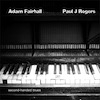 While the use of old blues samples in modern songs is hardly a new idea, this is a great example of when a seemingly overused concept is reinvigorated. Here, the jazz pianist Adam Fairhall teams up with Paul J Rogers (best known to readers of Brainwashed as a member of The Long Dead Sevens) to mix the old with the new, highlighting the continuum of recorded music in the 20th century and performers in the 21st. The merging of Fairhall’s skill as a pianist along with Rogers more studio-orientated talents has lead to this fantastic collection of recordings which may not shatter all expectations but certainly put more life into the blues than most contemporary efforts.
While the use of old blues samples in modern songs is hardly a new idea, this is a great example of when a seemingly overused concept is reinvigorated. Here, the jazz pianist Adam Fairhall teams up with Paul J Rogers (best known to readers of Brainwashed as a member of The Long Dead Sevens) to mix the old with the new, highlighting the continuum of recorded music in the 20th century and performers in the 21st. The merging of Fairhall’s skill as a pianist along with Rogers more studio-orientated talents has lead to this fantastic collection of recordings which may not shatter all expectations but certainly put more life into the blues than most contemporary efforts.
 
Throughout the album, Rogers uses a variety of recordings of old blues and jazz songs as jumping blocks for the duo’s own compositions. The dead men and women who lend their talents to Second-Handed Blues are all credited on the back of the album, this is not a wholesale plundering of found recordings but a celebration and reverent tribute to these artists. Granted some of the samples are treated but many are left as is, their power needing no tweaking or massaging to fit with Fairhall and Rogers’ playing.
Yet neither one of the pair holds back in their playing, they never sound like they are trying to create an ersatz version of the original recordings. Fairhall’s piano on "Stavin’ Chain" sounds like it could be one of Diamanda Galás’ takes on the blues. It is powerful, full of fire and determination and given an eerie quality by the clink of metal links in the background. The same can be said of Fairhall’s playing on "The Katy Line," where Rogers creates a sinister rhythmic noise that keeps changing in tone as Fairhall plays for his soul.
However, it is not just the Old Testament brimstone of the blues that is being worshiped here as "Ballad of a Backslider" shows. Here Fairhall’s playing is far closer to his home turf of jazz, pretty but as deep as the Mississippi itself. Instead of opting for the unsettling soundscapes described above, Rogers plays an interview with an old blues man (unidentifiable by me as it is not my area of expertise) over the music, creating a poignant and captivating piece.
As an idea, I was unsure of how well Second-Handed Blues would work but Fairhall and Rogers have convinced me that there is merit in their methods. The thoughts of relying on the old source material to carry the album left me cold but the duo have used these blues recordings as a springboard to making their own music in comparison to the likes of Moby or Fatboy Slim using similar samples with minimal artistic input on their behalf. As a result, Second-Handed Blues has a vibrancy to it that belies its roots in a style of music that is approaching its centenary.
samples:
 
Read More

